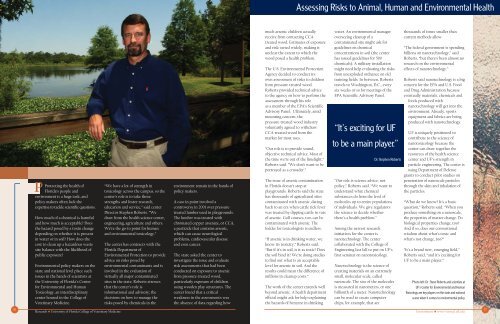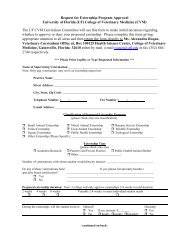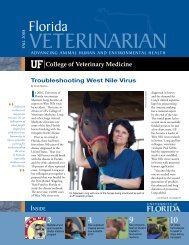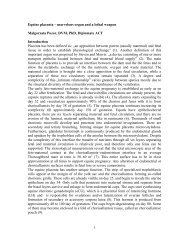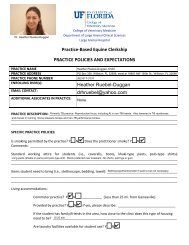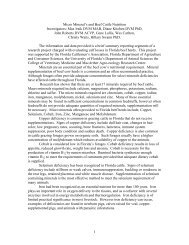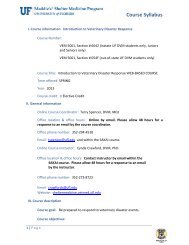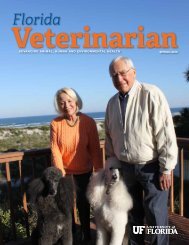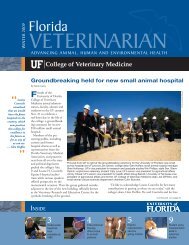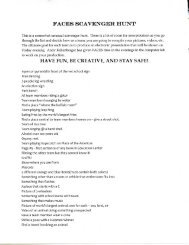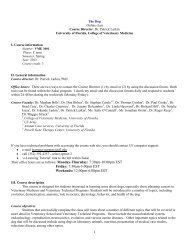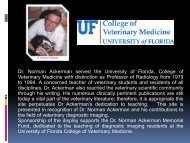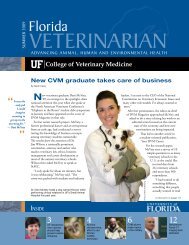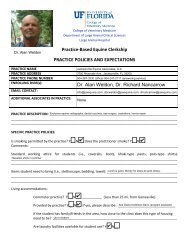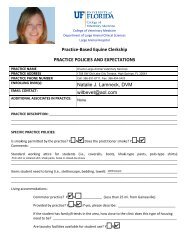College of Veterinary Medicine Research Brochure
College of Veterinary Medicine Research Brochure
College of Veterinary Medicine Research Brochure
- No tags were found...
You also want an ePaper? Increase the reach of your titles
YUMPU automatically turns print PDFs into web optimized ePapers that Google loves.
Assessing Risks to Animal, Human and Environmental Health36PProtecting the health <strong>of</strong>Florida’s people andenvironment is a huge task, andpolicy makers <strong>of</strong>ten lack theexpertise to tackle scientific questions.How much <strong>of</strong> a chemical is harmfuland how much is acceptable? Doesthe hazard posed by a toxin changedepending on whether it is presentin water or in soil? How does thecost to clean up a hazardous wastesite balance with the likelihood <strong>of</strong>public exposure?Environmental policy makers on thestate and national level place suchissues in the hands <strong>of</strong> scientists atthe University <strong>of</strong> Florida’s Centerfor Environmental and HumanToxicology, an interdisciplinarycenter housed in the <strong>College</strong> <strong>of</strong><strong>Veterinary</strong> <strong>Medicine</strong>.<strong>Research</strong> • University <strong>of</strong> Florida <strong>College</strong> <strong>of</strong> <strong>Veterinary</strong> <strong>Medicine</strong>“We have a lot <strong>of</strong> strength intoxicology across the campus, so thecenter’s role is to take thosestrengths and foster research,education and service,” said centerDirector Stephen Roberts. “Wedraw from the health science center,engineering, agriculture and others.We’re the go-to point for humanand environmental toxicology.”The center has contracts with theFlorida Department <strong>of</strong>Environmental Protection to provideadvice on risks posed byenvironmental contaminants and isinvolved in the evaluation <strong>of</strong>virtually all major contaminatedsites in the state. Roberts stressesthat the center’s role isinformational and advisory; thedecisions on how to manage therisks posed by chemicals in theenvironment remain in the hands <strong>of</strong>policy makers.A case in point involved acontroversy in 2001 over pressuretreatedlumber used in playgrounds.The lumber was treated withchromated copper arsenate, or CCA,a pesticide that contains arsenic,which can cause neurologicalproblems, cardiovascular diseaseand even cancer.The state asked the center toinvestigate the issue and evaluaterisk assessments that had beenconducted on exposure to arsenicfrom pressure-treated wood,particularly exposure <strong>of</strong> childrenusing wooden play structures. Thecenter found that a criticalweakness in the assessments wasthe absence <strong>of</strong> data regarding how••much arsenic children actuallyreceive from contacting CCAtreatedwood. Estimates <strong>of</strong> exposureand risk varied widely, making itunclear the extent to which thewood posed a health problem.The U.S. Environmental ProtectionAgency decided to conduct itsown assessment <strong>of</strong> risks to childrenfrom pressure-treated wood.Roberts provided technical adviceto the agency on how to perform theassessment through his roleas a member <strong>of</strong> the EPA’s ScientificAdvisory Panel. Ultimately, amidmounting concern, thepressure-treated wood industryvoluntarily agreed to withdrawCCA-treated wood from themarket for most uses.“Our role is to provide sound,objective technical advice. Most <strong>of</strong>the time we’re out <strong>of</strong> the limelight,”Roberts said. “We don’t want to beportrayed as a crusader.”The issue <strong>of</strong> arsenic contaminationin Florida doesn’t stop atplaygrounds. Roberts said the statehas thousands <strong>of</strong> agricultural sitescontaminated with arsenic, datingback to an era when cattle tick feverwas treated by dipping cattle in vats<strong>of</strong> arsenic. Golf courses, too, can becontaminated with arsenic. Thefodder for toxicologists is endless.“If arsenic is in drinking water, weknow its toxicity,” Roberts said.“But if it’s in soil, is it as toxic? Doesthe soil bind it? We’re doing studiesto find out what is an acceptablelevel for arsenic in soil. And theresults could mean the difference <strong>of</strong>millions in cleanup costs.”The work <strong>of</strong> the center extends wellbeyond arsenic. A health department<strong>of</strong>ficial might ask for help explainingthe hazards <strong>of</strong> benzene in drinkingwater. An environmental manageroverseeing cleanup <strong>of</strong> acontaminated site might ask forguidelines on chemicalconcentrations in soil (the centerhas issued guidelines for 500chemicals). A military installationmight need help evaluating the risksfrom unexploded ordnance on oldtraining fields. In between, Robertstravels to Washington, D.C., everysix weeks or so for meetings <strong>of</strong> theEPA Scientific Advisory Panel.“It’s exciting for UFto be a main player.”Dr. Stephen Roberts“Our role is science advice, notpolicy,” Roberts said. “We want tounderstand what chemicalsubstances do from the level <strong>of</strong>molecules up to entire populations<strong>of</strong> individuals. We give regulatorsthe science to decide whetherthere’s a health problem.”Among the newest researchinitiatives for the center isnanotechnology. The centercollaborated with the <strong>College</strong> <strong>of</strong>Engineering last fall to put on UF’sfirst seminar on nanotoxicology.Nanotechnology is the science <strong>of</strong>creating materials on an extremelysmall, molecular scale, callednanoscale. The size <strong>of</strong> the moleculesis measured in nanometers, or onebillionth <strong>of</strong> a meter. Nanotechnologycan be used to create computerchips, for example, that arethousands <strong>of</strong> times smaller thancurrent methods allow.“The federal government is spendingbillions on nanotechnology,” saidRoberts, “but there’s been almost noresearch on the environmentaleffects <strong>of</strong> nanotechnology.”Roberts said nanotechnology is a bigconcern for the EPA and U.S. Foodand Drug Administration becauseeventually materials, chemicals andfoods produced withnanotechnology will get into theenvironment. Already, sportsequipment and fabrics are beingproduced with nanotechnology.UF is uniquely positioned tocontribute to the science <strong>of</strong>nanotoxicology because thecenter can draw together theresources <strong>of</strong> the health sciencecenter and UF’s strength inparticle engineering. The center isusing Department <strong>of</strong> Defensegrants to conduct pilot studies onpenetration <strong>of</strong> nanoscale particlesthrough the skin and inhalation <strong>of</strong>the particles.“What do we know? It’s a basicquestion,” Roberts said. “When youproduce something on a nanoscale,the properties <strong>of</strong> matter change. Dobiological properties change, too?And if so, does our conventionalwisdom about what’s toxic andwhat’s not change, too?”“It’s a brand new, emerging field,”Roberts said, “and it’s exciting forUF to be a main player.”Photo left: Dr. Steve Roberts and scientists atUF’s Center for Environmental and HumanToxicology are key players on the state and nationalscene when it comes to environmental policy.Environment • www.vetmed.ufl.edu37


